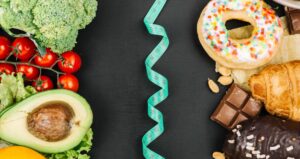In today’s bustling grocery stores and flashy packaging, making informed dietary choices can be challenging. Deceptive marketing claims and confusing labels often leave us wondering – what’s really in this food? Luckily, by understanding How To Read Food Labels, you can empower yourself to make intelligent choices that align with your health goals.
Table of Contents
ToggleUnveiling the Mystery: Why Food Labels Matter
Have you ever noticed a product boasting “healthy” or “natural,” yet the ingredients list reads like a science experiment? This highlights the importance of food labels. Misleading marketing is prevalent, and labels are crucial to decoding the truth about what you’re putting in your body. By understanding food labels, you can:
- Make informed choices: Labels reveal a product’s nutritional content, allowing you to compare and choose options that align with your dietary needs.
- Prioritize healthy eating: Identifying hidden sugars, unhealthy fats, and essential nutrients empowers you to make healthier choices for yourself and your family.
- Avoid misleading claims: Don’t fall victim to clever marketing tactics. Labels provide factual information about the product, allowing you to see through the hype.
Cracking the Code: Decoding the Ingredients List
The ingredients list, often on the back of the package, is a goldmine of information. Since the ingredients are stated in decreasing weight order, the first ingredient represents the most significant percentage of the final result. Observe the following:
- Whole, recognizable ingredients: The simpler the ingredient list, the better. Look for familiar entire foods like fruits, vegetables, and whole grains.
- Hidden sugars: Watch out for added sugars marketed under other names, such as brown sugar, dextrose, sucrose, and high-fructose corn syrup.
- Unhealthy fats: Saturated and trans fats are best limited. Watch out for ingredients like hydrogenated or partially hydrogenated oils, coconut, and palm oil.
Mastering the Nutrition Facts Panel: Your Guide to Nutritional Value
The nutrition facts panel is a detailed breakdown of a food’s nutritional content. Here’s a quick guide to deciphering the key terms:
- Serving size: Pay close attention to this, as all the information on the label is based on this amount. Be realistic – if you typically eat double the serving size, double the nutrient values.
- Calories: This reflects the energy a serving provides.
- Daily Values (DV): This percentage indicates how much of a nutrient a serving contributes to your daily needs. Aim for lower DVs for sodium and saturated fat and higher DVs for fiber and vitamins.
Deciphering the Numbers: Key Nutrients to Focus On
Now that you’ve grasped the basics let’s delve deeper into specific nutrients:
- Fat: Not every fat is created equal. Limit saturated and trans fats, which are present in processed foods and red meat, and emphasize heart-healthy unsaturated fats, such as those in avocados and olive oil.
- Carbohydrates: Carbs can be classified as good or bad. Fiber-rich carbohydrates (in whole grains and vegetables) are essential, while added sugars (often lurking in processed foods) should be limited.
- Protein is essential for the construction and repair of tissues. Fish, poultry, beans, and lentils are foods high in lean protein.
- Sodium: Elevated blood pressure can be attributed to a high-salt diet. Try to consume at most 2,300 mg of sodium each day.
- Vitamins and Minerals: These micronutrients are vital for various bodily functions. Look for foods rich in essential vitamins and minerals like Vitamin A, Vitamin C, calcium, and iron.
Beyond the Basics: Spotting Marketing Claims and Making Informed Choices
Food labels can be tricky. Don’t be fooled by marketing terms like “organic” or “healthy.” Organic means the ingredients were produced without synthetic pesticides or fertilizers. “Healthy” is a loose term – always check the label to verify the nutritional content.
Here are some red flags to watch out for:
- Large serving sizes: A small serving with high calorie or sodium content can be misleading.
- Misleading sugar content: Be wary of products boasting “low-fat” but loaded with hidden sugars.
Pro Tips for Label Reading Champions: Streamlining Your Grocery Shopping
Become a label-reading pro with these handy tips:
- Focus on critical ingredients: Prioritize products with whole, recognizable ingredients listed first.
- Compare similar products: Compare labels within the same category to choose the most favorable nutrient profile option.
- Utilize technology: Consider using label-reading apps to decode labels and provide additional nutritional insights.
Conclusion: How To Read Food Labels
Knowing what’s on food labels gives you the power to manage your health. When you make wise eating decisions, you’re investing in your health. Your body will appreciate you taking the extra time to read labels at the grocery store. Feel free to do so!
Frequently Asked Questions: Demystifying Common Label Reading Concerns
Q: What’s the difference between “use by” and “best before” dates?
- A: “Use by” indicates a safety concern – the product may spoil after this date. “Best before” refers to the product’s quality – flavor or texture may diminish after this date, but it’s generally safe to consume.
Q: Should I avoid processed foods altogether?
- A: Not necessarily. Some processed foods can be part of a balanced diet. Look for options with minimal processing, a short list of whole ingredients, and a favorable nutrient profile.
Q: What are some healthy alternatives to processed snacks?
- A: Opt for whole, unprocessed options like fruits, nuts, yogurt with fruit, or veggie sticks with hummus.
.Q: How can I make healthy choices on the go?
- A: Plan! Pack healthy snacks or grab single-serve options with clear labels that align with your dietary needs.
By incorporating these tips and making label reading a habit, you’ll be well on your way to confidently navigating the grocery aisles and making informed choices for a healthier you!

















